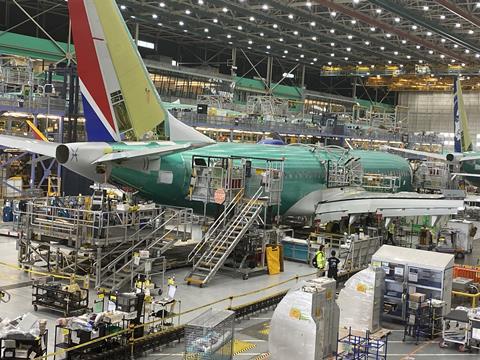The Federal Aviation Administration has identified quality shortcomings at Boeing and its supplier Spirit AeroSystems as part of an audit the agency launched following the January in-flight blow out of a 737 Max 9’s door plug.
The “six-week audit of Boeing and Spirit AeroSystems… found multiple instances where the companies allegedly failed to comply with manufacturing quality control requirements”, the agency said in an update released 4 March.
“The FAA identified non-compliance issues in Boeing’s manufacturing process control, parts handling, and storage and product control,” it adds.

The FAA says it has provided Boeing and Spirit with summaries of the audit’s conclusions, but the regulator has not released details and did not respond to a request for comment.
Last week, the FAA said it had given Boeing 90 days to submit a plan detailing how it intends to address quality control issues identified by both the audit and by a separate quality investigation completed by an independent safety panel convened by the FAA. The FAA released that panel’s final report on 26 February.
Asked to comment on 4 March, Boeing reiterated a statement it released last week.
“By virtue of our quality stand-downs, the FAA audit findings and the recent expert review panel report, we have a clear picture of what needs to be done. Transparency prevailed in all of these discussions,” the manufacturer says. “Boeing will develop a comprehensive action plan… Our Boeing leadership team is totally committed to meeting this challenge.”
“The FAA will thoroughly review all of Boeing’s corrective actions to determine if they fully address the FAA’s findings,” the FAA adds.
Wichita-based Spirit, which manufacturers 737 fuselages, did not immediately respond to a request for comment. Last week, Boeing said it has interest in acquiring Spirit as a means of improving quality and safety. Boeing in 2005 divested the operation that became Spirit as part of a broader push to outsource aircraft production.
Boeing chief executive David Calhoun has already said his company is responsible for the 5 January in-flight failure of an Alaska Airlines 737 Max 9’s mid-cabin door plug. The incident left a gaping hole in the side of the jet. The pilots landed safety without serious injuries to passengers or crew.
Bolts intended to secure the plug may have been removed by workers at Boeing’s 737 assembly site in Renton before the company delivered the jet, in October last year, to Alaska, according to a preliminary accident report released by the National Transportation Safety Board on 6 February. That finding suggests workers may never have replaced the bolts.
The door-plug failure also prompted the FAA to prohibit “expansion” by Boeing of its 737 Max production system. The FAA has declined to be more specific about what it has prohibited Boeing from doing. Additionally, the agency is considering appointing a third party to independently review Boeing’s quality systems.





























